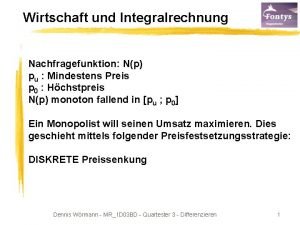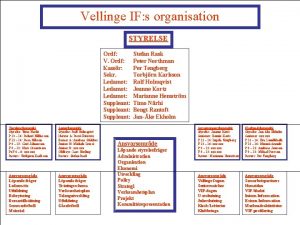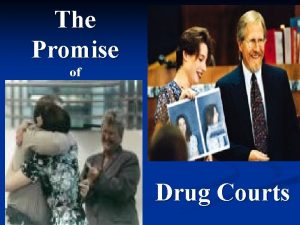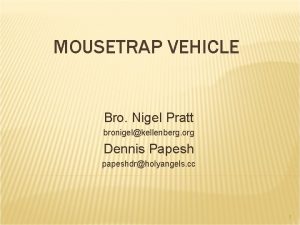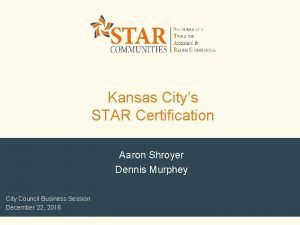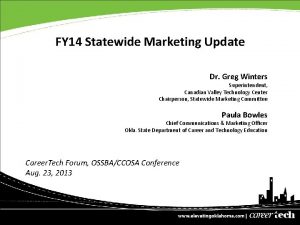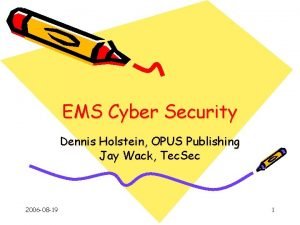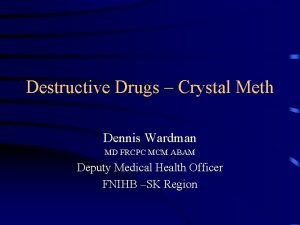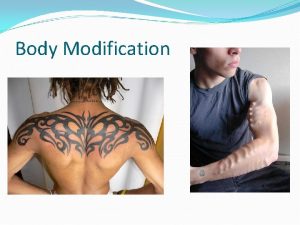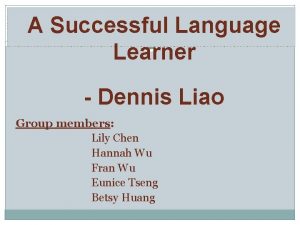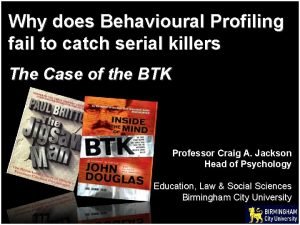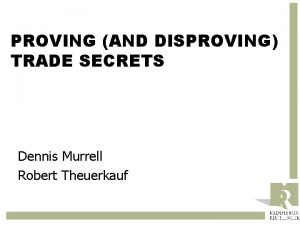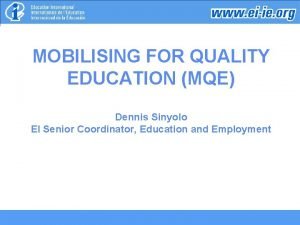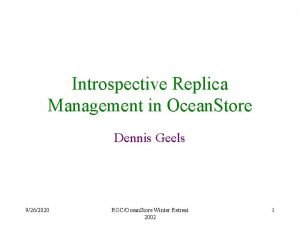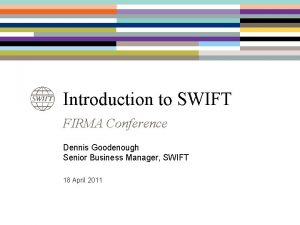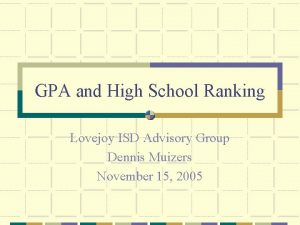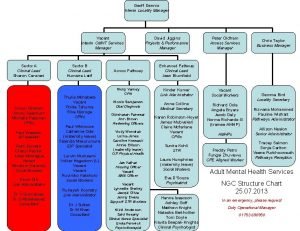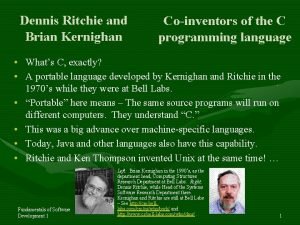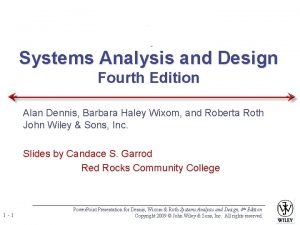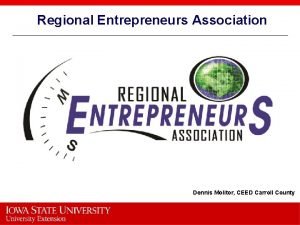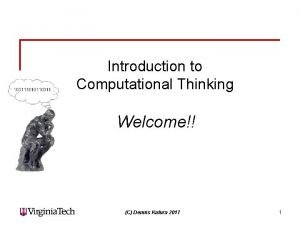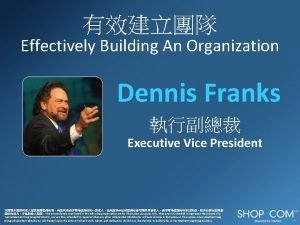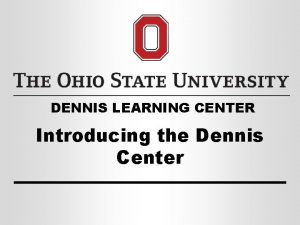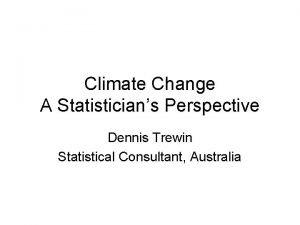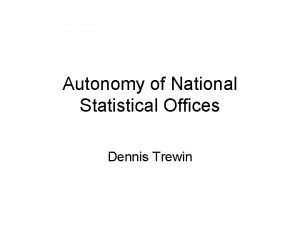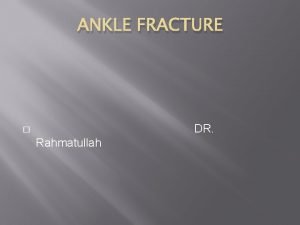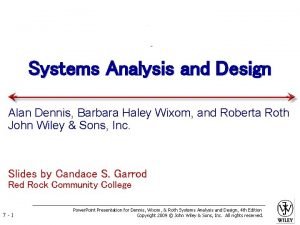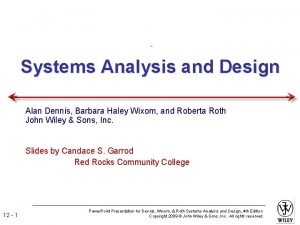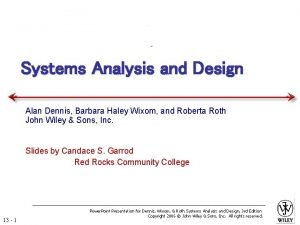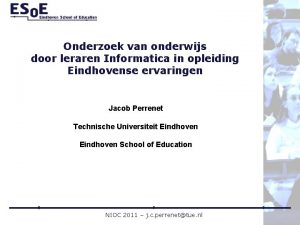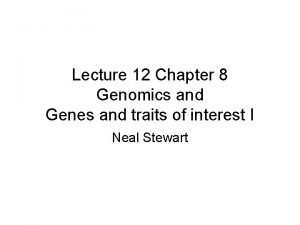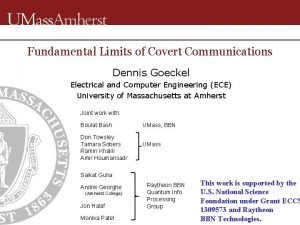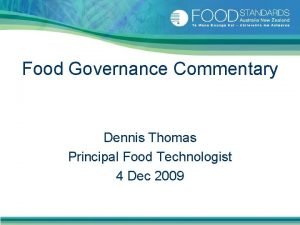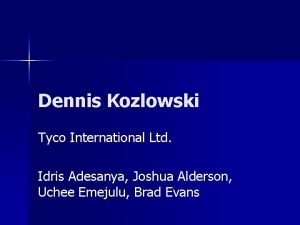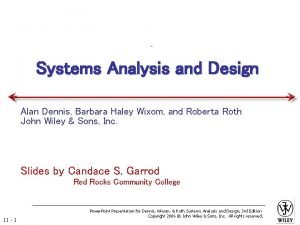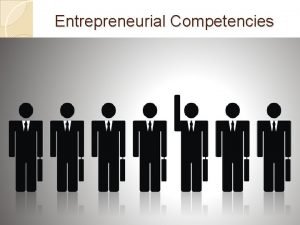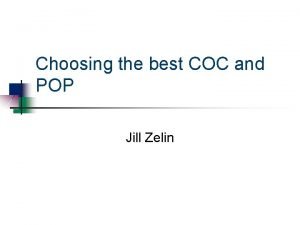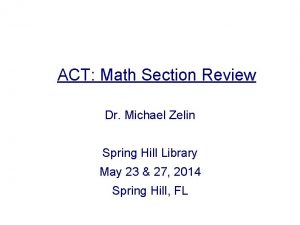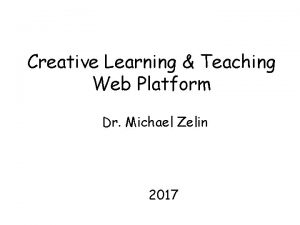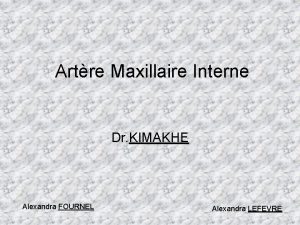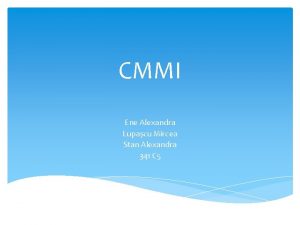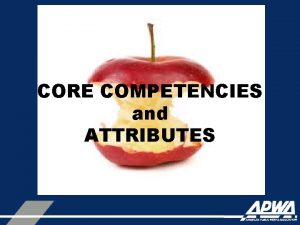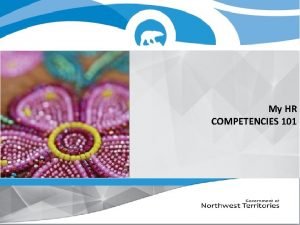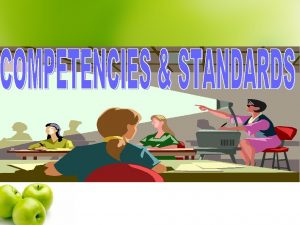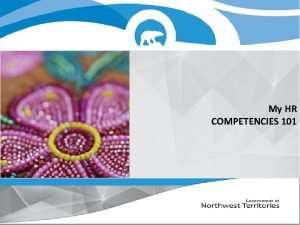How Can I Use Competencies Alexandra Zelin Dennis




































































- Slides: 68

How Can I Use Competencies? Alexandra Zelin Dennis Doverspike Kim Hollman Marianne Tonjes

Why Competencies? What is a competency? • Competencies are considered sets of behaviors • Such behaviors support workplace objective obtainment • For instance, working within Microsoft Excel to manage budgeting accounts. • Competencies are behaviors one needs to display to demonstrate successful performance • How one reaches desired outcomes • Competencies are not personal attributes • Thus, they are widely applicable to selection, training, development, performance management, succession planning, etc. • Competencies are not results and/or consequences of specific behaviors

Why Competencies? How is it different from a knowledge, skill, ability, and/or regular behavior? • Competencies involve mastering a certain behavior to successfully reach specific goals and/or outcomes • For instance, one needs to master social skills to effectively communicate with people in the workplace • Competencies are the integration of knowledge, skills and abilities; displaying competency is applying the knowledge, skills, and abilities that are required performance standards • A competency could include using short cuts in Microsoft Excel to achieve necessary data output. It is not just one knowing how to work Microsoft Excel, but actually performing that function in a competent manner • The behaviors one needs to display to be successful in a given role • Knowledge, skills, and abilities are job‐specific and unlimited. Competencies can be applied across multiple jobs and are typically limited • Thus, competencies are generally broader than knowledge, skills, and abilities

How are Competencies Useful? • Translation into training protocols • Creation of situational judgment test questions • Broad competency modeling vs. job‐specific competencies in developing a selection tool • Creation of structured interview questions

From the Ground Up: Developing Competencies in a University Setting For Use in Training Alexandra I. Zelin, Ph. D.

Overview Technology Training Group (TTG) at the University of Tennessee at Chattanooga (UTC) noticed a need for personnel training in various technological capacities Problem: unsure of the wide array of technical competencies necessary for success in all job qualifications around campus Goal: create a list of technology-related competencies used within various job families across the university that can be used to spearhead training initiaves

Step I: Interview Job family of Administrative Support Staff chosen for the pilot group 180 employees within this job family 90 contacted for an interview 75 interviews conducted

Step I: Interview What we learned: - Emphasize the goal of the study in the introduction - Dismiss ideas of “I am not qualified to answer this question”/ “I have not been on the job long enough to answer this question”

Step I: Interview What we learned: - The explanation of a competency is critical - May need to guide people through their days to gather all competency information

Step I: Interview

Step II: Design and Administer Competency Modeling Survey Collect basic demographic data Years in current position Gender Ethnicity Compiled a list of all competencies mentioned during interviews Combined similar competencies into one overall descriptor (e. g. , ARGOS reports and ARGOS)

Step II: Design and Administer Competency Modeling Survey Presented the list of competencies with two rating scales: “Please rate the following competencies with respect to their importance in your job position. ” 1 (Not Important) to 7 (Extremely Important) “Please rate the following competencies with respect to the frequency they are needed to be successful in your job position. ” Scale points included: “Never, ” “Rarely, less than 10% of the time, ” “Occasionally, about 30% of the time, ” “Sometimes, about 50% of the time, ” “Frequently, about 70% of the time, ” “Usually, about 90% of the time, ” and “All the time. ”

Step III: Results of the Competency Modeling Survey Mean Importance Ratings Technical Program Mean Importance Rating Microsoft Outlook* 6. 84 Microsoft Word* 6. 80 Microsoft Windows Operating 6. 71 System* Printer* 6. 61 Microsoft Excel* 6. 58 Internet Browser* 6. 45 Telephone System* 6. 45 S-drive 6. 23 Office 365* 6. 23 IRIS (SAP)* 5. 97 Note: A * indicates the program is ranked in the top 10 for mean importance and mean frequency.

Step III: Results of the Competency Modeling Survey Mean Frequency Ratings Technical Program Mean Frequency Rating Microsoft Outlook* 6. 59 Microsoft Windows Operating 6. 20 System* Microsoft Word* 6. 03 Internet Browser* 5. 67 Microsoft Excel* 5. 65 Printer* 5. 62 Telephone System* 5. 45 Office 365* 5. 20 Adobe 4. 94 IRIS (SAP)* 4. 90 Note: A * indicates the program is ranked in the top 10 for mean importance and mean frequency.

Step IV: Turning Competencies Into Training Directives Based on the importance and frequency of use ratings, the Microsoft Office Suite, the internet, printer, telephone system, and IRIS (accounting system) TTG is developing trainings on these technical programs to best fit the needs of employees in the Administrative Support Staff job family Other job families are going through the same interview and survey process to best fit training to their particular needs

HOW CAN I USE COMPETENCIES? Practical Measurement Of A Competency Model: Leadership In Public Safety Dennis Doverspike, Doverspike Consulting LLC

Dennis Doverspike, Doverspike Consulting LLC • Dennis Doverspike, Ph. D. , ABPP, is President of Doverspike Consulting LLC. He is certified as a specialist in Industrial‐Organizational Psychology and in Organizational and Business Consulting Psychology by the American Board of Professional Psychology (ABPP), serves on the Board of the American Board of Organizational and Business Consulting Psychology, and is a licensed psychologist in the State of Ohio. Dr. Doverspike has over forty years of experience working with consulting firms and with public and private sector organizations. He is the author of 3 books and over 150 other professional publications. Dennis Doverspike received his Ph. D. in Psychology in 1983 from the University of Akron.

Avesta, Greg Lawton, Partner • Greg Lawton brings thirty years of EMS and medical transportation senior management experience to Avesta. In 2007, he founded Avesta with the purpose of offering new strategies and innovative human resource solutions to the EMS industry. These solutions are backed by behavioral science insight, technology, and a thorough understanding of how EMS organizations function, and how industry regulations and challenges affect their every move.

NEMSMA • NEMSMA is a professional association of EMS leaders dedicated to the discovery, development, and promotion of excellence in leadership and management in EMS systems, regardless of EMS system model, organizational structure, or agency affiliation.

Problem – More General • How can we improve work (and satisfaction with work) for first responders and public safety employees? • More specifically, Emergency Medical Services (EMS) • EMS • Public Sector ‐ Fire Departments • Public Sector ‐ Stand Alone EMS Departments • Private Sector EMS • Hospital Based EMS • Jobs • Paramedics and EMTs • Supervisors • Managers • Executives

Multi-Prong Approach of Applied Research 1. Entry Level Selection and Testing 1. Personality Assessment 2. Physical Ability Tests (PATs) 3. Testing for Potential CWBs 2. Improving Leadership 1. Through Competency Models 2. Certification and Credentialing 3. Surveying Attitudes and Engagement

The Problem • Start with competency model for leadership in public safety • More specifically, leadership in Emergency Medical Services (EMS) • Supervisors, Managers, and Executives • Turn it into tests or assessments appropriate for certification testing or credentialing using a competency model • Movement in health care and with heath care providers • Solution ‐ Several types of assessments • Traditional Knowledge Tests • Situational Judgment Tests (SJTs) • Oral Boards

Basics and Definitions

Competencies • A worker‐oriented, higher level characteristic • Which can be linked to associated KSA clusters • Defined in terms of behavioral exemplars • Allows for operationalization and measurement • Competency Modeling • Technique similar to job analysis • But intended for the identification of competencies • Competency Measurement • Move beyond simple knowledge based testing

The NEMSMA COMPETENCY MODEL

5 Competencies for Translation into SJTs • • • Self Attributes Leading Others Task Management Innovation Social Responsibility

• Credentialing ‐ refers to a guarantee to the public that individuals in a profession have met certain standards. • Encompasses licensure and certification. CERTIFICATION OR CREDENTIALING • Licensing ‐ the granting of permission by some authority, usually in the United States a state or state board, to an individual to practice an occupation. Is generally mandated by law. • Certification – a recognition that an individual has voluntarily met some requirement set by an organization. Generally voluntary. • Thus, it is critical to remember that certification is a voluntary process. And, different from pre‐employment or employment testing.

Approach: Competencies into SJTs

New Element – SJTs for Competencies • Decision to use Situational Judgment Test (SJT) items • What is an SJT? • Mike Mc. Daniel & Deb Whetzel • Winfred Arthur

SJT • Low fidelity simulation • Dilemmas relate to core competencies • Ideal for jobs with a great deal of interaction with others • Job relevant scenario – followed by alternatives • A number of scoring solutions • Due to nature – used single correct answer • You notice a man robbing a store. What would you do? 1. Leave the store quickly. 2. Try to apprehend the robber. 3. Call the police. 4. Nothing, just keep shopping.

TRADITIONAL ELEMENTS • Job Analysis • Source List • For Job Knowledge Test • Also valuable in writing SJT • Collection of Critical Incidents

Critical Incidents We are going to ask you to write‐up critical incidents for the Supervising EMS Office. You will be given a specific competency, and then you will be asked to write a critical incident for this competency. A critical incident, think: About a time when someone did something really good (or bad) A recent challenge at work A crisis – (fire, shooting, hurricane) Someone made a mistake Someone did an exceptional job You were particularly proud

Critical Incidents Your competency is: SELF ATTRIBUTES (Work Habits, Work Attitudes, Stress Management, Self Insight, and Learning). • We would like you to think of an effective incident. • Recalling this incident, please describe the incident or situation. What led to this situation? • What would be an expert or excellent response in this situation? • What would be an average or minimally competent response? • What would be a poor or unacceptable response?

Write Items Based on Competencies 1. Sort and Analyze Critical Incidents 2. Turn critical incidents, values, and competencies into item stems 3. Generate Response choices • What would be the best thing to do? • What is a bad response that you think many people would do? • What would a poor employee do? • What would really good employee do? 4. Edit responses 5. Develop Scoring Key 6. Pilot

Typical Competency Model Definition of Leadership: A leader motivates and drives others. A leader is willing to make decisions and resolve conflicts. A leader is engages in ethical behavior. Level of Competence Prototypical Behaviors Easily Exceeds Expectations and Performs at Expert Level Seen by others as a leader. Is confident. Drives change and inspires others to take ownership of change. Motivates others to high levels of performance. Is willing to make decisions even when criticized by others or in times of crisis. Maintains high levels of ethical behavior and inspires others to do the same. Identifies conflicts before they occur. Meets Expectations Is seen by others as a leader in some situations. Makes a case that change is necessary and acts in a manner to try to get others to accept changes. Motivates others to meet set goals. Is willing to make decisions, especially when it is an area in which they have experience. Adheres to ethical standards in own behavior. Listens to others and resolves disagreements when they occur. Below Expectations Lacks confidence in self. Others lack confidence in the ability to lead. Fails to make a strong case for change. Actions fail to motivate others. Prefers to leave decisions to others. Does not always consider ethical issues. Avoids dealing with conflicts.

Typical Competency Scales 3. Exceeds Expectations ‐ Expert 2. Meets Expectations 1. Below Expectations 4. Expert 3. Advanced 2. Competent 1. Novice

NEMSMA Competencies • Confidence ‐ The supervising officer handles assignments efficiently and completes work punctually and with consistent, expected, quality. • Over Confident ‐ The supervising officer completes assignments early and meets minimum quality standards but could provide higher quality work if the full timetable was utilized without rushing through the projects. • Limited Confidence ‐ The supervising officer manages time ineffectively and has trouble completing tasks on schedule and/or with expected quality.

SJT Item You respond to assist one of your teams at a scene in a socioeconomically depressed section of town with a higher than average minority population. After the call, a person from the crowd approaches you. They complain that your EMS units “always” take a long time to respond. They also report the neighborhood is getting angry about this discrimination. What should you do: A. Talk calmly and inform him the perception of time often seems to move slowly in emergencies. Assure him you monitor response times and they are fine. B. Move him closer to the crowd so they can hear the exchange. Let him know response times are closely watched and they are within acceptable limits. C. Give him your business card. Ask him to arrange a community meeting with you & your manager to discuss the matter. Inform him response times are appropriate. ****D. Express concern for his comments. Let him know response times are monitored closely. Ask if he will help you speak with the community. Option or Alternative D, represents the best answer. Social Responsibility.

SJT Item Recently, your team has been the subject of a series of unfounded patient complaints. No one member in particular is the subject, but your Manager has met with you expressing his concern. You’ve noted no change in your team’s demeanor that would suggest they are mistreating patients. You should: A. Call a team meeting and let them know about the company’s concern. Remind them it is their professional obligation to act competently and with compassion. The patient’s perception is paramount. B. Call a team meeting and express the company’s disappointment. Remind them that discipline will result if anyone is found responsible for poor treatment of a patient. C. ****Call a team meeting and candidly advise them of what’s happening. Express your belief that they can overcome this and you will work with them as needed. D. Don’t worry the team with the company’s concern since the complaints are unfounded. This will only hurt morale. Praise them for the good work they do. Best answer: C

Pilot Testing Plus • Confirm correct answer • Job relevance or importance • Angoff estimate – likelihood of passing

• SJT approach represents a easy to use and implement approach to: Results and Conclusions • Testing for competencies • In a certification or credentialing setting • Excellent fit to requirements • Decent reliability

• Scoring? • Correct Answer? Issues • Number of alternatives? • Depends on competency? • Use in certification or credential testing ‐ traditionally knowledge based.

THE END

USING COMPETENCIES IN CIVIL SERVICE TESTING Kimberly Hollman, M. A. Cuyahoga County Personnel Review Commission

Agenda • Cuyahoga County and the role of the PRC • Development of competency model • Application of competencies to different types of tests

Cuyahoga County and the PRC • Cuyahoga County has 7823 full-time employees • The PRC is an independent agency, and part of our role in the County is to provide civil service testing for competitive classifications • Since 2015, we have developed tests for over 140 unique classifications

Body of Work • Multiple tests representative of County’s jobs • Structured interviews • Skill and ability testing (e. g. , reading comprehension, typing, data entry, proofreading, etc. ) • Applied work samples (written, computerized, and practical) • Written exercises • Oral presentations

Role of Competencies • Tests are validated through job analysis • Factors affecting implementation of competencies: • Day-one KSAs identified in job analysis • Number of qualified candidates • Resource availability

Competency Model for Interviews • Identified 16 competencies assessed through interviews Structured Interview Competencies Conflict Management Employee Development & Feedback Ethics & Integrity Initiative & Problem Solving Interpersonal Skills Maintaining Composure Managing Work Motivating Others Oral Communication Process Improvement Professional Development Promoting Teamwork Research & Analysis Safety Teamwork & Collaboration Time Management & Prioritization

Structured Interview Bank • Created bank of 100 questions across 16 competencies • Applies to multiple job situations • Standardized scoring methods • Includes interviewer training guidelines

Example: Conflict Management Effective Behaviors • Focuses on common goals and interests • Identifies points of agreement • Shows respect for other side and their positions • Tries to understand other sides’ perspective • Takes a problem-oriented approach; describes the problem and its impact, not the characteristics of the person Ineffective Behaviors • Ignores conflict rather than addressing it • Accommodates instead of compromising • Gives in and says yes too soon • Gets upset as a reaction to conflict; takes it personally • Excessively competitive and has to win every dispute

Conflict Management • Example Interview Item Describe a prior work experience when you faced a conflict with a client or customer. What was the context of the situation, what did you to do resolve the conflict, and what was the outcome? Rationale: This item assesses a candidate’s ability to respond to client/customer concerns and implement solutions in a professional manner.

Example Scoring Anchors Describe a prior work experience when you faced a conflict with a client or customer. What was the context of the situation, what did you do to resolve the conflict, and what was the outcome? • 4 points: 7+ of the following actions: • Remained calm and professional. • Listened to and understood client concerns. • Asked clarifying questions if necessary. • Explained reasons/rationale behind actions previously taken. • Took ownership for their role in conflict; apologized if necessary. • Discussed potential solutions to the problem. • Implemented a solution that was acceptable to both sides; ensured compliance with applicable standards. • Monitored situation; followed up with client. • Took steps to prevent problem from occurring in the future. • 3 points: 5 -6 actions • 2 points: 3 -4 actions • 1 point: 1 -2 actions • 0 points: 0 actions

Applying Competencies to Other Tests • Identify ways in which competencies can be integrated in test • Example: Senior Training Officer (Children & Family Services) • Scheduling work sample • SJT • Constructed response

Summary • All competencies are based on KSAs from job analysis • Competencies are applied to different types of tests • Implementation of competencies depends on factors such as the classification, the number of candidates, and resource availability

Competency-Based Interviews Marianne Tonjes Executive Director CODESP www. codesp. com

Competency Based Interviews Traditional hiring has focused primarily on evaluating a candidate's skills and technical qualifications Competency questions include an analysis of a candidate's behavioral characteristics as well Begins with identification of core competencies required for success Followed by the subsequent evaluation of each candidate's demonstration of those competencies in their past experiences

Advantages of Competency-Based Interviews “You can teach a turkey to climb a tree, but is easier to hire a squirrel” Competence at Work by Spencer and Spencer

CODESP Development Steps We chose LA County of Office of Education’s Competency Dictionary created by Rod Freudenberg Ph. D.

Customer Development Steps Adopt a Competency Model Conduct a job analysis Conduct interviews and focus group discussions with Job Experts Identify Link essential tasks for each job competencies to each job task.

Select Competencies with Job Expert Sample List Personal Effectiveness Action and Results Focus - Initiating tasks and focusing on accomplishment Adaptability - Responding positively to change and modifying behavior as the situation requires Attention to Detail - Focusing on the details of work content, work steps, and final work products Handling Stress - Maintaining emotional stability and self-control under pressure, challenge, or adversity Innovation - Imagining and devising new and better ways of doing things Learning Agility - Seeking learning opportunities and applying the lessons to one's work Professional Integrity and Ethics - Displaying honesty, adherence to principles, and personal accountability Self-Management - Showing personal organization, self-discipline, and dependability

Criticality of the Competency Scale Value Definition (0 -3) 0 Possession of the Competency is NOT RELATED to overall satisfactory job performance. Does Not Apply 1 Possession of the Competency is HELPFUL to overall satisfactory job performance. Moderately Important 2 Possession of the Competency is IMPORTANT to overall satisfactory job performance. Important 3 Possession of the Competency is VERY IMPORTANT to overall satisfactory job performance. Very Important 4 Possession of the Competency is CRITICAL to overall satisfactory job performance. Importance (0 -4) Critical

Link Competencies To Tasks Scale Value Definition (0 -2) Relationship to Job Performance (0 -1) 0 Possession of this Competency is NOT RELATED No Observable Relationship to successful overall performance of this task. 1 Possession of this Competency is DESIRABLE, but not essential, for the overall satisfactory performance of this task. 2 Possession of this Competency is IMPORTANT for the overall satisfactory performance of this task. Observable Relationship

Task – Competency Matrix To what extent is each Competency needed when performing each job task? 4 = Extremely necessary, the job task cannot be performed without the Competency 3 = Very necessary, the Competency is very helpful when performing the job task 2 = Moderately necessary, the Competency is moderately helpful when performing the job task 1 = Slightly necessary, the Competency is slightly helpful when performing the job task 0 = Not necessary, the Competency is not used when performing the job task Competency A B C D E F Task 1 4 3 4 0 1 3 Task 2 2 4 2 0 0 1 Task 3 0 0 0 4 2 1 Task 4 0 1 0 0 4 0

Competencies Used in Interviews Essential competencies are turned into questions which require the applicant to typically provide specific, detailed descriptions of how the candidate behaved in the past

Competency to Interview Questions ADAPTABILITY-Maintaining effectiveness in varying environments, tasks and responsibilities, or with various types of people. Tell me about a situation in which you have had to adjust to changes over which you had no control. How did you handle it? Tell me about a time when you had to adjust to a colleague's working style in order to complete a project or achieve your objectives. By providing related examples, convince us that you can adapt to a wide variety of people, situations and environments.

CODESP Interview Builder Competency / Job Family Choose Family questions by either Competency and/or Job

Using the Interview Builder for a Competency Search by Job Level
 Alexandra zelin
Alexandra zelin Dennis wörmann
Dennis wörmann Dennis kortz vellinge
Dennis kortz vellinge Judge dennis challeen
Judge dennis challeen Systems analysis and design dennis
Systems analysis and design dennis Openstack marca blanca
Openstack marca blanca Dennis h mahan memorial bridge
Dennis h mahan memorial bridge Dennis papesh
Dennis papesh Little britain narrator
Little britain narrator Dennis murphey
Dennis murphey Dr greg winters
Dr greg winters Genre kortfilm
Genre kortfilm Dennis holstein
Dennis holstein Dennis wardman
Dennis wardman Dennis bushnell
Dennis bushnell Dennis avner avant
Dennis avner avant Dennis liao
Dennis liao Dennis lyn rader
Dennis lyn rader Dennis carlin
Dennis carlin Systems analysis and design alan dennis
Systems analysis and design alan dennis Systems analysis and design alan dennis
Systems analysis and design alan dennis Systems analysis and design alan dennis
Systems analysis and design alan dennis Systems analysis and design alan dennis
Systems analysis and design alan dennis Dennis murrell
Dennis murrell Projektcontrolling regelkreis
Projektcontrolling regelkreis Dennis sinyolo
Dennis sinyolo Denis geels
Denis geels Swift firma
Swift firma Lovejoy high school ranking
Lovejoy high school ranking Lurvin munisami
Lurvin munisami Dennis van gelder
Dennis van gelder Kernighan and ritchie
Kernighan and ritchie Dennis ugolini
Dennis ugolini 300 word stories brady dennis
300 word stories brady dennis Dennis fawcett
Dennis fawcett Systems analysis and design alan dennis
Systems analysis and design alan dennis System analysis and design alan dennis
System analysis and design alan dennis Systems analysis and design alan dennis
Systems analysis and design alan dennis Systems analysis and design alan dennis
Systems analysis and design alan dennis Dennis molitor
Dennis molitor Isscc tutorial
Isscc tutorial Dennis papadopoulos
Dennis papadopoulos Dr dennis winters
Dr dennis winters Dennis kafura
Dennis kafura Dennis frank 美安
Dennis frank 美安 Dennis learning center
Dennis learning center Dennis trewin
Dennis trewin Dennis dutterer
Dennis dutterer Differential equations zill solutions
Differential equations zill solutions Truewin branches
Truewin branches Dennis weber classification
Dennis weber classification Dennis groenenboom
Dennis groenenboom Oregon health authority brenda dennis
Oregon health authority brenda dennis Systems analysis and design alan dennis
Systems analysis and design alan dennis Systems analysis and design alan dennis
Systems analysis and design alan dennis Systems analysis and design alan dennis
Systems analysis and design alan dennis Dennis geyer
Dennis geyer Dennis ramsdahl jensen
Dennis ramsdahl jensen Informatica middelbare school
Informatica middelbare school Dennis silverman
Dennis silverman Gtopo
Gtopo Dennis gonsalves
Dennis gonsalves La rimembranza zibaldone testo
La rimembranza zibaldone testo Dennis goeckel
Dennis goeckel Dennis food technologist
Dennis food technologist Dennis brezina
Dennis brezina Dennis kozlowski net worth
Dennis kozlowski net worth Advanced engineering mathematics dennis g zill 4th edition
Advanced engineering mathematics dennis g zill 4th edition Systems analysis and design alan dennis
Systems analysis and design alan dennis

